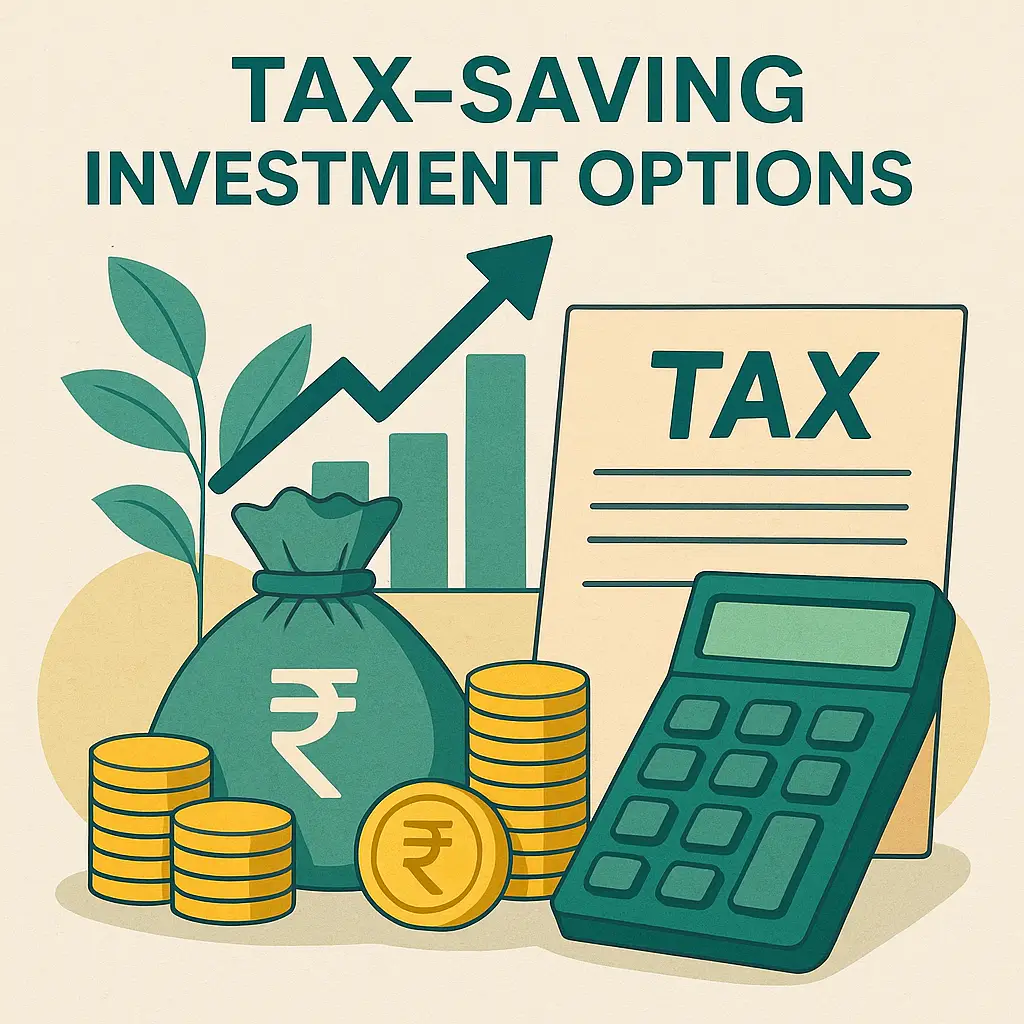
Every year, as the financial year comes to a close, millions of Indians scramble to save tax at the last moment — often making rushed, suboptimal investments.
But what if you could plan your investments smartly and strategically, so you not only reduce your tax liability but also build long-term wealth?
In this article, we’ll break down the most effective tax-saving investment options available, especially under the Income Tax Act’s popular Section 80C and beyond.
Whether you’re a salaried employee, business owner, or freelancer — understanding these options can help you keep more of your hard-earned money.
Section 1: Understanding Section 80C
Section 80C of the Income Tax Act allows a deduction of up to ₹1.5 lakh per year from your taxable income.
That means if you fall in the 30% tax bracket, you could save up to ₹45,000/year just by using 80C smartly.
Section 2: Top 80C Tax-Saving Investments
✅ 1. ELSS (Equity Linked Saving Schemes)
ELSS are mutual funds with a 3-year lock-in, offering tax benefits and market-linked returns.
| Feature | Value |
|---|---|
| Lock-in Period | 3 years (lowest among 80C) |
| Returns | Market-linked (10–15% historical) |
| Risk | Moderate to high |
| Liquidity | Medium (post lock-in) |
| Ideal For | Young investors, long-term wealth |
Why It’s Smart: Combines tax-saving with equity growth potential.
Example: Invest ₹1.5 lakh/year in ELSS for 10 years = potentially ₹25–30 lakh corpus.
✅ 2. PPF (Public Provident Fund)
A government-backed, long-term savings scheme with guaranteed returns.
| Feature | Value |
|---|---|
| Lock-in Period | 15 years (partial withdrawal after 7 years) |
| Interest Rate | ~7.1% (updated quarterly) |
| Tax Treatment | EEE (Tax-free at all stages) |
| Ideal For | Risk-averse, long-term investors |
Why It’s Smart: Tax-free interest + sovereign guarantee.
✅ 3. EPF (Employees’ Provident Fund)
Mandatory for salaried employees in organized sector.
- 12% of basic salary deducted monthly (employer matches)
- Interest ~8.15%
- Tax-exempt under 80C
- Partial withdrawal allowed for specific needs
Why It’s Smart: Forced savings with high interest and tax benefits.
✅ 4. Sukanya Samriddhi Yojana
Meant for the girl child (below age 10), backed by Govt. of India.
| Feature | Value |
|---|---|
| Interest Rate | ~8.2% (highest in 80C) |
| Lock-in | Until girl turns 21 |
| Tax Status | EEE |
| Ideal For | Parents of daughters |
✅ 5. National Savings Certificate (NSC)
Fixed-income product from post office.
- 5-year lock-in
- Interest ~7.7%
- Safe, low-risk
- Interest reinvested (counts for 80C)
✅ 6. 5-Year Tax-Saving Fixed Deposits
Offered by most banks and post offices.
| Feature | Value |
|---|---|
| Lock-in | 5 years |
| Returns | 6.5%–7.5% (taxable) |
| Tax Benefit | Only under 80C |
| Ideal For | Conservative investors |
Section 3: Beyond 80C – Additional Tax-Saving Instruments
✅ 1. NPS (National Pension System) – Section 80CCD(1B)
- Additional deduction up to ₹50,000
- On top of ₹1.5 lakh under 80C
- Invested in equity + debt (you can choose proportion)
- Ideal for retirement planning
Returns: 8–10% (market-linked)
Tax at Exit: 60% corpus tax-free, rest goes into annuity
✅ 2. Health Insurance Premium – Section 80D
| Who Covered | Max Deduction |
|---|---|
| Self, Spouse, Children | ₹25,000 |
| Parents (<60 yrs) | ₹25,000 extra |
| Parents (60+ yrs) | ₹50,000 extra |
Total max deduction possible: ₹1 lakh/year
Buying health insurance early ensures coverage and tax savings.
✅ 3. Home Loan Principal and Interest – Sections 80C + 24(b)
- Principal repayment → up to ₹1.5 lakh under 80C
- Interest on home loan → up to ₹2 lakh under Section 24(b)
- First-time buyers → Additional ₹50,000 under 80EEA (conditions apply)
✅ 4. Education Loan – Section 80E
- Deduction for interest paid on loan (no limit)
- For higher education (self, spouse, children)
- Up to 8 years
Section 4: Smart Tax-Saving Strategies
✅ Start Early in the Financial Year
Waiting till March leads to rushed and emotional decisions.
Instead:
- Plan in April
- Use monthly SIPs in ELSS
- Align tax-saving with goals (like retirement, child education)
✅ Mix of Debt + Equity
| Goal | Product |
|---|---|
| Wealth Creation | ELSS, NPS (equity-focused) |
| Stability | PPF, FD, NSC |
| Retirement | NPS, PPF |
| Short-term saving | FDs, NSC |
| Girl child goal | Sukanya Samriddhi Yojana |
✅ Consider Tax-Efficiency of Returns
| Product | Returns | Tax on Maturity |
|---|---|---|
| ELSS | 10–15% | 10% LTCG over ₹1 lakh |
| PPF | 7.1% | Tax-free |
| NPS | 8–10% | Partial tax (40%) |
| FD | 6.5–7% | Fully taxable |
| SGB | ~6–8% | Tax-free on maturity |
Section 5: Tax-Saving for Salaried Employees
- 80C: PPF, EPF, ELSS, Term Insurance
- 80D: Health insurance
- 24(b): Home loan interest
- 80CCD(1B): NPS additional ₹50k
- HRA Exemption: If living on rent
- LTA, Standard Deduction, Professional Tax
Tip: Always submit investment proofs by Jan–Feb to avoid excess TDS.
Section 6: Common Mistakes to Avoid
❌ Rushing tax-saving in March
❌ Ignoring lock-in periods
❌ Choosing products that don’t suit your goals
❌ Not reviewing old investments
❌ Investing only to save tax — not grow wealth
Section 7: ELSS vs PPF vs FD – Quick Comparison
| Feature | ELSS | PPF | FD (5-yr) |
|---|---|---|---|
| Lock-in | 3 years | 15 years | 5 years |
| Returns | 10–15% | 7.1% | ~6.5% |
| Risk | High | Low | Low |
| Tax on Returns | 10% over ₹1L | None | Fully taxable |
| Best For | Long-term wealth | Safe corpus | Short-term savings |
Section 8: Real-Life Case Study
Amit, 30, salaried employee:
| Goal | Product | Amount Invested |
|---|---|---|
| Retirement | NPS | ₹50,000 |
| Wealth creation | ELSS via SIP | ₹75,000 |
| Emergency corpus | FD | ₹50,000 |
| Health security | Health Insurance | ₹20,000 |
| Total Tax Savings | ₹1.95 lakh invested | Saved ₹55,000 tax |
Conclusion: Save Tax and Grow Wealth Together
Tax-saving isn’t just about reducing liability — it’s about aligning your money with your life goals.
By planning early, choosing the right products, and diversifying across risk levels, you can:
- Build retirement wealth
- Protect your family
- Meet life milestones
- And still save ₹40,000–₹60,000 in taxes every year
Don’t just save tax. Let your money grow smartly.


